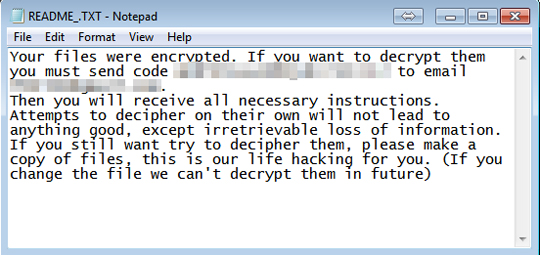RANSOM_CRYPKEYIV.A
Trojan-Ransom.Win32.Crypren.acsa (Kaspersky), Ransomware-FNA!C0B834F87051 (McAfee)
Windows


Threat Type: Trojan
Destructiveness: No
Encrypted: No
In the wild: Yes
OVERVIEW
Downloaded from the Internet
This Trojan arrives on a system as a file dropped by other malware or as a file downloaded unknowingly by users when visiting malicious sites.
TECHNICAL DETAILS
19,456 bytes
EXE
No
13 Jun 2016
Encrypts files, Displays message/message boxes
Arrival Details
This Trojan arrives on a system as a file dropped by other malware or as a file downloaded unknowingly by users when visiting malicious sites.
Installation
This Trojan adds the following mutexes to ensure that only one of its copies runs at any one time:
- MyAppMutex
Other System Modifications
This Trojan modifies the following file(s):
- It encrypts files and appends the extension .7h9r
Other Details
This Trojan encrypts files with the following extensions:
- *.3gp
- *.7z
- *.apk
- *.avi
- *.bmp
- *.cdr
- *.cer
- *.chm
- *.conf
- *.css
- *.csv
- *.dat
- *.db
- *.dbf
- *.dbx
- *.djvu
- *.doc
- *.docm
- *.docx
- *.epub
- *.fb2
- *.flv
- *.gif
- *.gz
- *.ibooks
- *.iso
- *.jpeg
- *.jpg
- *.key
- *.md2
- *.mdb
- *.mdf
- *.mht
- *.mhtm
- *.mkv
- *.mobi
- *.mov
- *.mp3
- *.mp4
- *.mpeg
- *.mpg
- *.pict
- *.pkg
- *.png
- *.pps
- *.ppsx
- *.ppt
- *.pptx
- *.psd
- *.rar
- *.rtf
- *.sav
- *.scr
- *.swf
- *.tbl
- *.tif
- *.tiff
- *.torrent
- *.txt
- *.vsd
- *.wmv
- *.xls
- *.xlsx
- *.xml
- *.xps
- *.zip
- *.ckp
- *.java
- *.py
- *.cpp
- *.asm
- *.c
- *.js
- *.cs
- *.php
- *.rb
- *.rbw
- *.dacpac
- *.db3
- *.dcx
- *.mrg
- *.sql
- *.sqlite
- *.sqlite3
- *.sqlitedb
It drops the following file(s)/component(s):
- {folder containing encrypted files}\README_.TXT - ransom note
It does the following:
- It enumerates drives and encrypts files in those drives
- It deletes itself via cmd.exe after its encryption routine:
- "C:\Windows\System32\cmd.exe" /C choice /C Y /N /D Y /T 3 & Del "{malware path and filename}"
NOTES:
The dropped ransom note README_.TXT contains instructions how to decrypt the files:

SOLUTION
9.800
12.588.08
13 Jun 2016
12.589.00
14 Jun 2016
Step 1
Before doing any scans, Windows XP, Windows Vista, and Windows 7 users must disable System Restore to allow full scanning of their computers.
Step 2
Note that not all files, folders, and registry keys and entries are installed on your computer during this malware's/spyware's/grayware's execution. This may be due to incomplete installation or other operating system conditions. If you do not find the same files/folders/registry information, please proceed to the next step.
Step 3
Identify and terminate files detected as RANSOM_CRYPKEYIV.A
- Windows Task Manager may not display all running processes. In this case, please use a third-party process viewer, preferably Process Explorer, to terminate the malware/grayware/spyware file. You may download the said tool here.
- If the detected file is displayed in either Windows Task Manager or Process Explorer but you cannot delete it, restart your computer in safe mode. To do this, refer to this link for the complete steps.
- If the detected file is not displayed in either Windows Task Manager or Process Explorer, continue doing the next steps.
Step 4
Search and delete these files
- README_.TXT
Step 5
Scan your computer with your Trend Micro product to delete files detected as RANSOM_CRYPKEYIV.A. If the detected files have already been cleaned, deleted, or quarantined by your Trend Micro product, no further step is required. You may opt to simply delete the quarantined files. Please check this Knowledge Base page for more information.
Step 6
Restore encrypted files from backup.
Did this description help? Tell us how we did.

